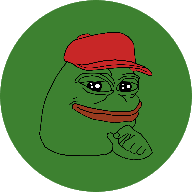A young lady from Chengdu, who is only 21 years old, has achieved a monthly income of 7 figures and an annual income of 8 figures by driving a Faraday ++ with one hand. This is also my position for many years.
A friend of mine in the currency circle, we met a while ago and talked about her glorious history. She spent 3 years learning and practicing in the currency circle. She said that making money is too easy.
It is simple. Many people think it is too complicated. Learn to grasp a set of indicators and make orders according to the charts. Do not make orders without seeing the pattern. Her winning rate is as high as
100%, winning every battle
Through my own practice, the winning rate is as high as 100%. I have sorted it out in the past few days and now share it with those who are interested.
Come learn and master, it is worth collecting!
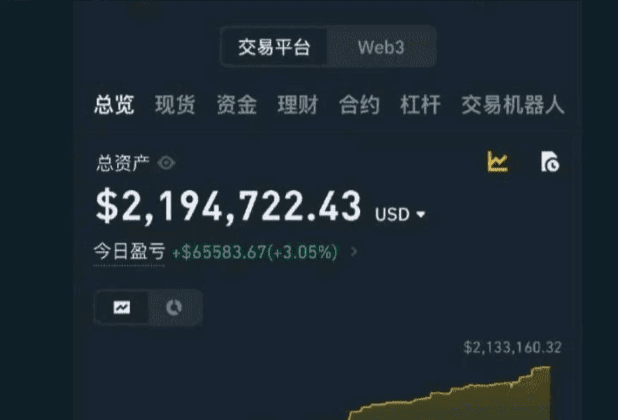
Let’s discuss the nature of price. Suppose there is a trading pair tokenA+/tokenB+, how is the price of tokenA determined?
Price is the result of supply and demand. Price is the liquidity + (quantity) ratio of A and B. A and B are two parts of a liquidity pool.
The constant product formula of the transaction exchange rate is x*y=k. Therefore, when a large number of A tokens are purchased, it will lead to a shortage of A tokens and an increase in price.
The relationship between supply and demand determines the price of token A. The first is the operation of providing liquidity for the AB trading pair, which determines the initial trading exchange rate.
If the exchange rate is too high or too low compared to the market, arbitrage traders will quickly close the gap until it reaches the normal market level.
2. Discuss the relationship between liquidity and price
Liquidity itself has nothing to do with price. The only factor that affects price is supply and demand. Liquidity is large enough to reflect the market process.
In fully traded stocks, prices are the result of fierce competition, while for stocks with low liquidity, prices may deviate from their actual value to a large extent.
3. Describe in your own words what a limit order+ and a market order+ are.
A limit order means that the user's buy or sell must be executed at a specified price.
If the price of BTC is 6500 USD, and investors want to buy at 6300 USD, they need to submit a purchase order of 6300 USD.
If the price reaches 6300 USD, the order will have a chance to be executed. If the price is lower than 6300 USD, the order will be fully executed. At this time, the average transaction price will usually be lower than 6300 USD.
A market order will execute the order at the current price of the virtual currency. If the latest price of BTC is 6500USD, then the execution price
The price is likely to be this price, or around this price.
4. Describe in your own words what is position-by-position and what is cross-position
【Full Position】means that all available balance in the account can be used as margin to avoid forced liquidation.
The advantage of this model is that as long as the leverage is moderate, the possibility of liquidation is very low, so it is often used for hedging and quantitative
trade.
[Isolated Margin] When a user's position is liquidated, only the margin amount of the position will be lost, and other funds in the contract account will not be affected.
In the isolated position mode, the margin is the user's biggest loss.
For example, if you have 10 USDT in your contract account and you open a position with 1 USDT invested, you will have 9 USDT left in your contract account. With a fixed position, the first 1 USDT invested at the time of opening the position will be used, leaving the remaining 9 USDT unaffected. Leverage can be used to maximize your profits with limited risk. With a full position, you will initially invest 1 USDT. If your margin is insufficient, USDT will be automatically transferred from the 9 USDT in your contract account to your contract position to avoid forced liquidation. This allows your contract position to be more resilient to adverse short-term market fluctuations.
5. Are the contract market and spot market settled separately or together? They are settled separately. For example, the spot market is one market, and the contract market is another. Trading in the spot market does not affect the contract market, so they are separate.
6. What is the Funding Rate++ in the contract? Why is it designed? Assuming the funding rate is 0.02%, does the short position pay the long position, or does the long position pay the airdrop? Does this mean the contract price is higher or lower than the spot price?
Funding rate is the price balancing mechanism of perpetual contracts*. It refers to the periodic fee paid to long or short traders based on the price difference between the perpetual contract market price and the spot price.
Because perpetual swaps don't have an expiration settlement mechanism like fixed-term contracts, most exchanges currently use funding rates to adjust the contract price to maintain a consistent level of price fluctuation when the perpetual swap price deviates from the spot price. When the market trend is bullish, the funding rate is positive and tends to increase over time. In this scenario, long perpetual swap traders pay funding fees to their counterparties. Conversely, when the market trend is bearish, the funding rate is negative, and short perpetual swap traders pay funding fees to long perpetual swap traders.
0.02% long to short money means the contract price is higher than the spot price
7. What are the two actions that short selling is essentially a combination of? Why do we short sell?
First borrow money at a high price and sell it, then buy it back after it falls. In this way, the purchase is still at a low price, and the sale is still at a high price.
Sell first and buy later
To make money. Short selling is a way to profit from falling investment prices. Through research/analysis, there are reasons to be bearish. If you short an asset and the investment price falls, you will gain profit. Generally speaking, the lower the price falls, the greater the profit in the transaction.
For example, if the current price of Bitcoin is USD 60,000, and I predict that it will drop to USD 58,000 tomorrow or in the next few days, I will buy the dip, that is, short it. If it does not drop but rises instead, I will lose money.
8. The price of Ethereum is 1200, the contract is shorted 1x, and the margin is 2600. So, at what price will your position be liquidated?
1x short position, 100% increase (1/1) margin call, 2400
9. The price of Ethereum is 1200, the contract is long 10 times, and the margin is 2600. At what price will your position be liquidated?
If you go long at 10 times, a 10% drop (1/10) will result in a margin call, and if 1080 drops 1/N
10.What is the initial margin used for?
The initial margin is the minimum margin required for a user to open a position. For example, if the initial margin is set at 10%, the user's opening price is
For a contract with a value of S1,000, the initial margin required is $100, which means the user has 10x leverage.
use
If the margin is less than $100, you cannot open a trade.
11.What is the relationship between Margin Ratio+ and Leverage+?
Leverage = 1/Margin Rate Leverage is inversely proportional to the margin rate. For example, if you want to trade without margin
To trade one standard lot of USD/JPY, you'll need $100,000 in your account. However, the margin requirement is only 1%, so you only need to deposit $1,000 in your account. The leverage offered for this trade is 100:1.
12. How to interpret the term "Anti-Order+"? Tips (Initial Margin, Maintenance Margin)
Simply put, holding a position is the act of being unwilling to close a position and stop loss. The reason is: unwilling to admit one's mistakes and do not want to lose principal. Therefore, it is necessary to hold the position so that when the position is lifted, you can say "I was right" and feel that you have defeated the market.
13. How to explain the term "margin call"? Tips (initial margin, maintenance margin) What is a margin call?
A margin call occurs when your available margin reaches zero. Without available margin, you can no longer trade. A margin call occurs when your losses exceed your available funds after deducting margin. The remaining funds after forced liquidation are your total funds minus your losses, which usually leaves a small amount.
14. Which one is used to settle margin calls, Mark Price+ or Last Price? What is the difference between Mark Price and Last Price? Why do we need Mark Price?
Mark Price. The mark price is used to calculate the user's unrealized profit and loss, the estimated triggering liquidation price, and calculate the user's funding fees.
Its purpose is to improve the stability of the contract market and reduce unnecessary liquidation when the market fluctuates abnormally. The latest market price refers to the platform
The current market price. The latest market price is always anchored to the spot price due to the funding mechanism, which is why the latest market price is not the same as the spot price.
The reason why spot market prices deviate too far.
15. Describe in your own words what unrealized profit and loss are
Unrealized P&L is the profit or loss held on your current open orders. Your current active trades. This is equal to the profit or loss that would be "realized" if all your open orders were closed immediately. Unrealized P&L is also called "floating P&L" because it is constantly changing as your positions remain open. If you have open orders, your unrealized P&L will fluctuate with the current market price.
Continued volatility (or "floating". For example, if you currently have unrealized profits, that unrealized profit could turn into an unrealized loss if the price moves against you.
16. Assume your initial margin is 1000u, the funding rate is 0.1%, your leverage is 10x long, and you settle three times a day.
How much funding do I need to pay/get?
1000u*0.1%103=30u
17. Describe hedging in your own words
Because the contract is a two-way transaction, you can buy long and sell short. Buying long and selling short at the same time is equivalent to always making no profit or loss, doing hedging. It is also called locking position.
[Because the loss is too large, it will lead to liquidation or forced liquidation]
18.Which is less likely to cause a margin call, low or high leverage?
It is not possible to say that low multiples are more dangerous or high multiples are safer, which is one-sided. The correct statement is that under the same position, low multiples can bear
The fluctuation is smaller and the distance to the liquidation price is closer. As for the choice of multiples, it is more a matter of personal trading system and habits.
Profits are always accompanied by high risks. Many people who talk about contracts only emphasize the benefits of the contracts without mentioning the risks. This is very scary.
In the cryptocurrency world, if you want to earn 1 million yuan in principal first, there is only one way to earn 1 million yuan in principal from tens of thousands of yuan, and that is rolling position.
I have sorted out the essence of the [PA Naked K Strategy]. As long as you master it, you can rely on this method to trade cryptocurrencies and your account will be guaranteed to increase 30 times.
Today I specially sorted out some useful information to share with those who are interested. Please keep it well.
I will explain PriceAction+ in the simplest and clearest way.
The basic logic of PriceAction proves to you that it is a very simple and practical concept. It is the greatest guarantee for us as retail investors to survive in the market. Once you master it, it can become your market advantage, allowing you to flexibly customize different response methods and trading plans in various market conditions without having to struggle. Of course, I am not a Taoist priest or Buddha, and it does not mean that you will be invincible after learning PriceAction.
I can only guarantee that during the trading process, your reaction to the market will be faster, your entry time will be more accurate, and your chances of success will be increased. If this is your first time to meet me
Welcome, here you will learn everything about trading
Students who are interested in money-making techniques, remember to follow me so as not to miss it, we will start right away!
1. What is PriceAction
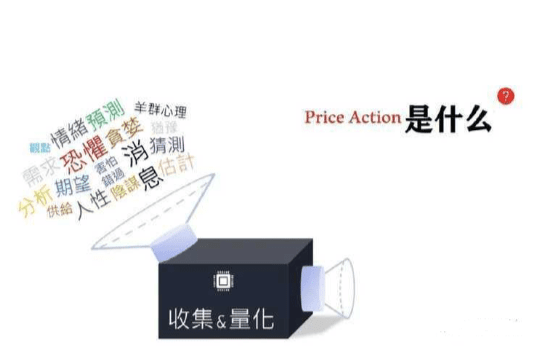
We know that whether it is the foreign exchange market, stock market, futures market or the cryptocurrency market, there are many things that cannot be quantified.
Emotions, fear, greed, human nature, conspiracies, expectations, predictions, opinions, news, etc.
So can we pack all of this into a huge processor and convert it into a quantized number?
value
Of course! This value is the K-line
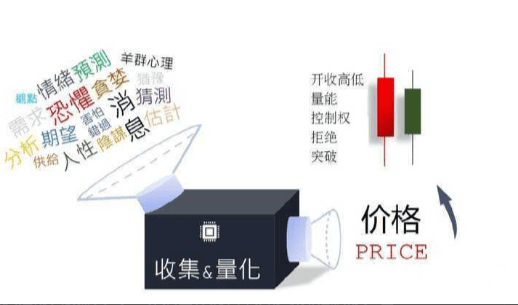
The value of K-line itself is already very great. We can actually get a lot of information just by looking at K-line.
If we use a knife to disassemble the K line, we will find that at different times, different positions, and different markets, we will see buying and selling.
Home and sellers give us different feedback, and this feedback is PriceAction (price behavior)
In simple terms
PriceAction (price action) consists of three parts
1. Market structure
2. K-line pattern
3. Chart patterns
These three parts have different usage and logic
PriceAction is translated into Chinese as: Price Action
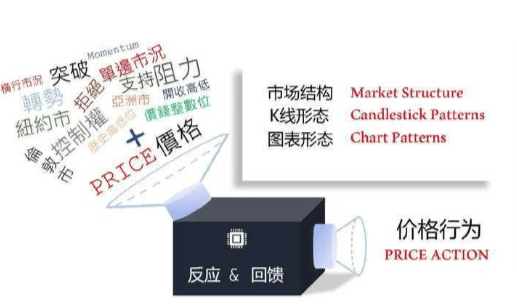
What is behavior?
When we humans do anything at any time, there is a logic and reason behind it. The same is true for the market, because the K-line
Behind the scenes is the collision of human nature
Next
We will separate the above three parts. If you feel that you have gained a lot after reading them, please follow me.
Because in the near future, I will be focusing on the various parts of PriceAction.
Explain the logic behind each form and its optimal usage separately
2. Market Structure
Usually when we look at charts
Whether it is stocks or digital currencies
Often disturbed by different messages, emotions, speculations, or various news
Distract us
Instead, we ignore the real structure of the market
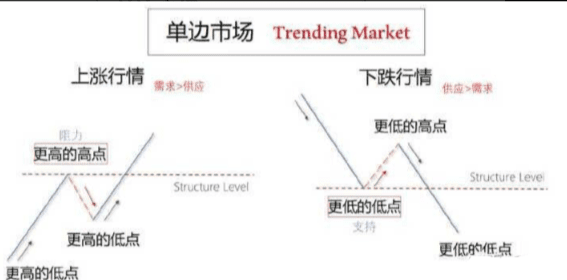
Method 1:
Prices are on the rise
Will continue to create higher highs, higher lows, and higher highs
(That is, constantly setting new highs)
In a downtrend
It will continue to form lower lows, lower highs, and lower lows.
(That is, constantly setting new lows)
When the market is in a one-sided market
Every time the price creates a new high or low
Will form new support and pressure levels invisibly
Our most common
Every time a new high or a new low is reached
Will rebound to the previous high or low point
That's why
We often see on the disk
Yesterday's resistance becomes today's support
Yesterday's support becomes today's resistance
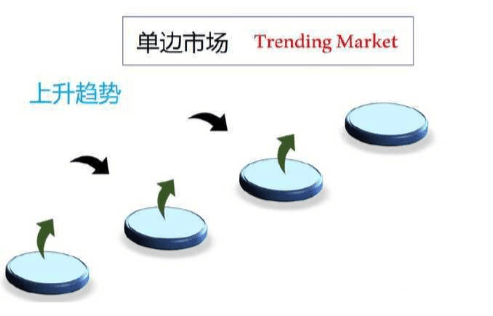
It's like high jump
Upward step by step
Each time it jumps to the next new high
Falling back due to the influence of gravity
Then use the reaction force to jump higher
Repeatedly, jumping higher and higher
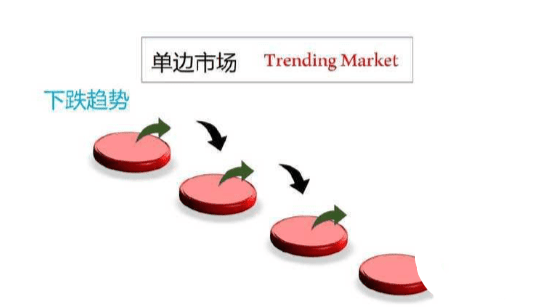
The same goes for a downtrend
Jump down one level at a time
Jumping lower and lower
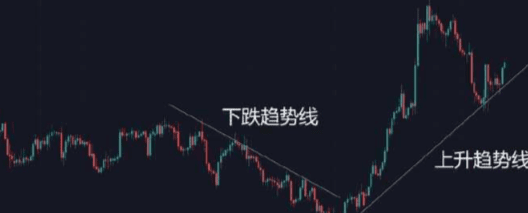
Method 2:
But many times
The market does not develop strictly according to the situation described in the book
What we see more often is a chaotic market
at this time
We can use trend lines to help us judge market trends
Generally speaking
As long as there are 2 points, they can be connected into a line
And judge its strength by its slope
The steeper the slope, the stronger the trend.
On the contrary, the flatter the trend line, the weaker the trend.
In a sense
The trend line itself is the support and resistance level
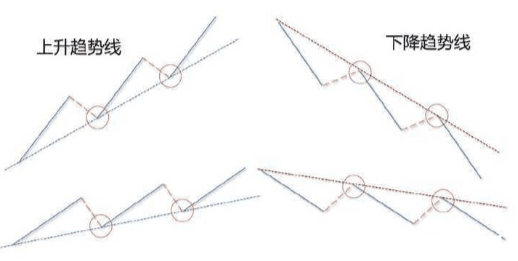
In an upward trend
The market has been following this trend line
Every time it touches this support level, it will rise
In a downward trend
Step by step
Following this trend line
Every time it hits this resistance level, it will fall.
In our daily transactions
If we apply the superpotential line
Combined with the key position concept just now
Will greatly increase the success rate of transactions
The above two methods
This is the most common method of using PriceAction to judge market trends.
[Turning Point]
Generally speaking
In an upward trend
We won't go against the market like idiots.
To do the selling operation
On the contrary, in a downtrend
We don't want to buy
None of us knows how long a trend will last.
You shouldn't just guess.
So sell at the top.
Or maybe you just feel the price is too low.
You can buy at the bottom
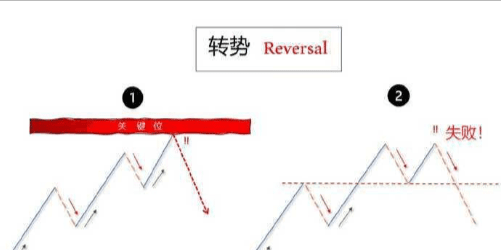
I usually only do this in the following two situations
Only then will we make a trade that goes against the trend
They are:
The price reaches a strong and critical support and resistance level and cannot break through;
Or the unilateral market trend has failed

Case 1
You need to pay attention to how the price reacts when it encounters major support and resistance levels.
Generally, we call this kind of support and pressure position "key position"
The so-called key position is different from the general support and pressure position
More effective and more accurate
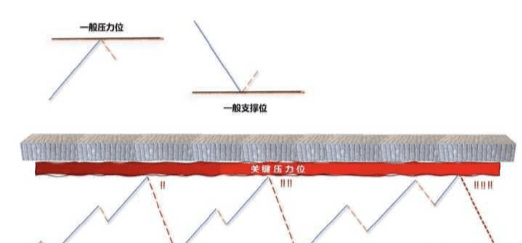
In simple terms
You can compare the general support and pressure point to a thin piece of wood.
Although it has a certain hardness
But there is still a chance to break it with bare hands
The key is a brick
Although the price will also hit hard
But I just can't break through this strong and powerful position
These positions are often occupied by long-term institutional investors.
Deploy entry or exit locations
Therefore, false breakthroughs, sharp rises or sharp falls often occur.
Once you understand the concept of key positions
You will understand:
Why my list
It was going smoothly and was profitable.
But suddenly it plummets or rises sharply
Or why do I often hit my stop loss position?
Keep going in the direction I predicted.
Similar situations in the future
It can be greatly reduced

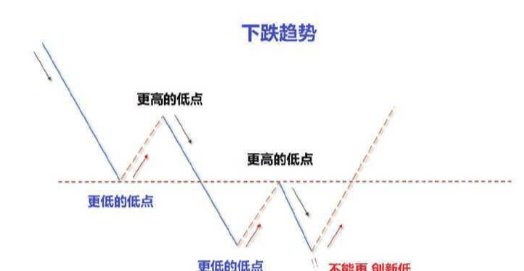
Method 2
Is to use fundamentals to determine whether the market trend has changed
When the upward trend can no longer reach a new high
At the same time, the price fell below this key support level
We will regard it as a super trend starting to reverse and fall.
In a downward trend
When the downward momentum is no longer sufficient to push the price to a new low
The price is pulled up by the opposite force
Breakthrough of key resistance level
We would consider it to be about to start a new uptrend
【Sideways】
Case 3: Sideways fluctuation
This is what we often encounter in the market.
Except in very extreme cases
No market will rise or fall forever.
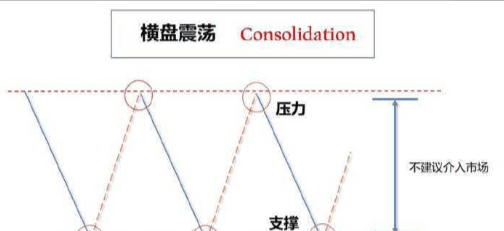
As long as there is a relatively high level in the market
Someone will take profit and leave
Of course, some people will choose to wait and see
There will also be a relatively low
Some people think it is worth buying and start buying domestic products at the bottom
Plus different news, different perspectives, different analyses
Temporarily creating a balance in the market
No clear direction
Until one of the parties breaks this balance at some point
It has evolved into a one-sided market
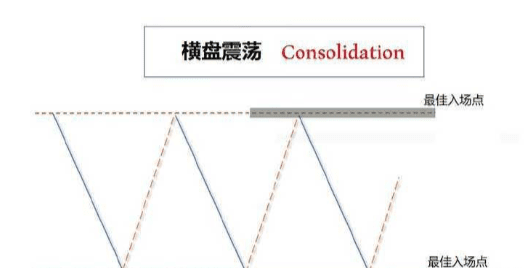
Buffett said: Only gods can make stable profits in swing trading
So here
My advice to you is
Try not to intervene in the transaction during a sideways fluctuation
Otherwise you will be fooled by the market
Whatever you buy is wrong
If you must trade in a volatile market
Then please follow the following two points
Otherwise you will lose all your pants.
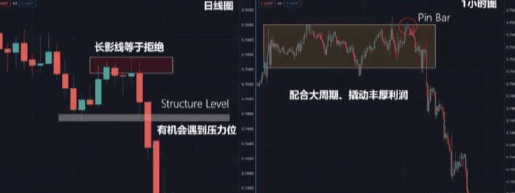
1. Cooperate with the big cycle
Take this example
I see on the daily chart that the price is in a downtrend
Currently making a callback upward
And the K-line a day or two ago has already shown a long shadow
This sign is like our proof
The current market correction may be almost over.
Prepare to continue falling
At this time, we look at the small cycle 1 hour chart
At the top of the volatile market
A Pinbar candlestick pattern appears
This is a typical bearish candlestick pattern.
so
When the small time chart and the large time chart are in place
The success rate of this transaction will be higher
2. Make sure your profit-loss ratio is no less than 1:1
I think this sentence needs no explanation
If your profit-loss ratio for each transaction is less than 1:1
In the long run, your position will only gradually decrease.
Willing to lose but not to win is a big taboo in trading
Don't make trades that result in more losses than gains
Otherwise your capital curve will be very unhealthy
Here we go
The core of PriceAction - market structure is now explained
3. K-line pattern
When you see here
congratulations
Have successfully entered the door of PriceAction
What to do next
Just look at charts and practice more
As long as you can accurately identify the situations just mentioned
No matter in any period or any situation
You have the ability to discern what the market is doing
It will help you filter out many wrong decisions
More flexible trading plan
Dramatically improve your trading performance
In the PriceAction component
Price accounts for a large proportion
At the beginning of the article I mentioned
The K-line candlestick is a graphical price.
We can obtain a lot of information that is helpful for our market analysis through K-line
But in order to make our transactions more convenient
The market has established regular quantitative signals for us
Therefore, various K-line patterns are derived.
Many times
In addition to the market structure we just learned
We also need to rely on the K-line pattern to provide us with double protection
Give us confidence in addition to the market structure we just learned
We also need to rely on the K-line pattern to provide us with double protection
Give us confidence
Triggering our transaction
Therefore, it is equally important to learn the K-line pattern well.
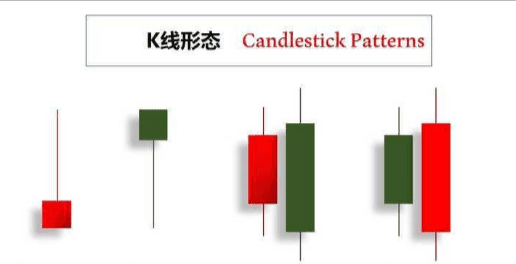
First, let’s briefly introduce the definition of this form.
Next I will tell you how to use the market structure in PriceAction
Find the most advantageous position
And use this K-line pattern to enter the market
Win a high-probability trade
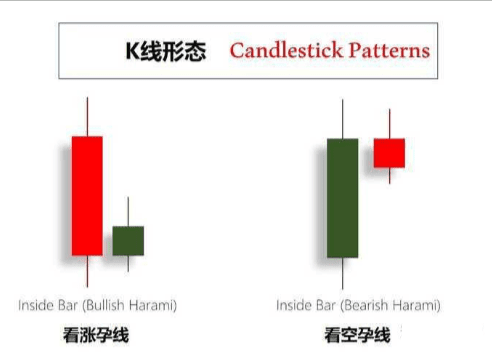
InsideBar
Because it looks like a pregnant woman
So the Chinese are called bearish pregnancy line and bullish pregnancy line
The bullish harami is composed of a black candlestick and a very small white candlestick.
This Yang line, whether it is a real body or a shadow line
All are within the previous K line
The bearish harami is the opposite
The body and shadow of the Yin line are both within the previous Yang line.
Generally speaking
There are two common ways to trade this pattern:

No. 1
When the price breaks through the high or low of the previous K line
Regardless of whether this latest K-line has ended
We all enter the market to buy or sell
Belong to the left side of the transaction
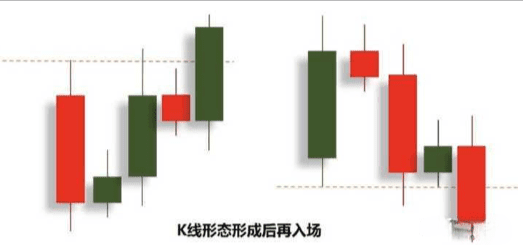
The second more conservative approach
Just wait for this K line now
It actually ends at the high or low point of the previous K-line
Enter the market only after you have established a firm direction

When we make trades based on K-line patterns
The most taboo thing is to enter the market immediately after seeing Pinbar
When we see PinBar, we sell it
Buy when you see a bullish engulfing candlestick
This is a very wrong approach
Because the K-line pattern
Their role should be to serve as confirmation models
Can only be used as an auxiliary
They are usually composed of no more than 3 K lines.
Therefore, it does not represent more comprehensive information and trends.
Use them individually to make trading decisions
Not a wise choice actually.
The best approach is to match the market structure
In a most advantageous position
Use the most accurate entry time
If you can understand this
I believe you will stay away from the bad mentality of chasing rising prices and selling falling prices
And it will not be too far away from stable profits
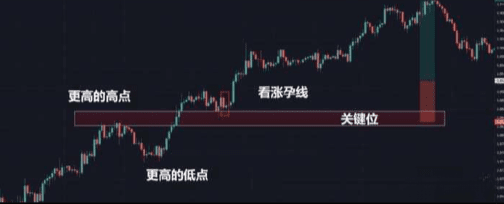
Let’s look at two examples of charts.
Example 1: Trend Continuation
In the picture above
The price hit a new high here and then started to pull back
At this time, a bullish harami appears here
A Yin line is sandwiched between a small Yang line
But this callback has slowed down
When the K-line pattern ends, it is followed by a big Yang line
Close above the bearish engulfing pattern
Prove that the buyer has officially returned
We choose to enter the market after the market closes here.
Set the stop loss to the nearest key level
The results proved that our deal was right
K-line drives the price upward smoothly
Successfully reached the take-profit point
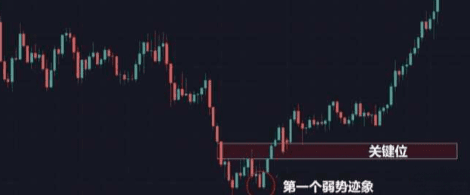
Example 2: Trend Reversal
In the picture above
We see a downtrend that continues for a while.
Prices are no longer hitting new lows
This is the first sign
This indicates that the trend is beginning to weaken.
After the price breaks through this key level
Then return to this position
At this time, I made a
Harami pattern
A Yin line completely encloses a small Yang line
When the next K line ends
Attempts to formalize the seller's trend have failed
Continue to rebound
4. Chart Patterns
What is chart pattern?
I believe that if you have done technical sharing for a period of time
You will find that the market will continue to do one thing through repeated patterns
The chart pattern provides such a trace.
So that we can follow the traces
Discover what the market is doing at this moment and the logic behind it
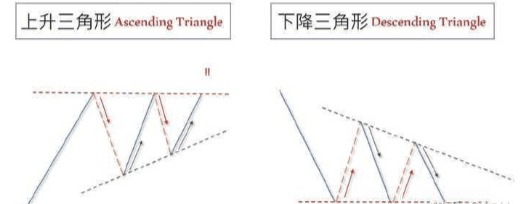
Today I am here to share with you two
Chart patterns often seen on the market
Ascending triangle
Descending triangle
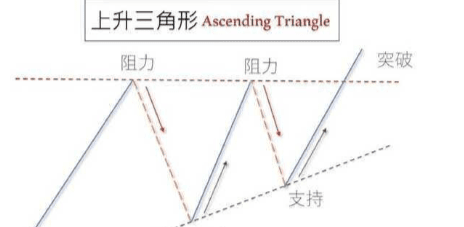
In an upward trend
The price encounters the first resistance level
This resistance level will become the base of this pattern.
The price starts to move slightly in the opposite direction
And this low point will become the lowest point of this pattern
When the price returns to the same position as the first resistance level
Will encounter resistance again
Go in the opposite direction again
But today's decline will be smaller than the last time
The downward force has weakened significantly
The second support is formed here
We connect the two low points with a straight line
Basically, this form has been formed
Wait until the price returns to this horizontal resistance level for the third time
The price successfully broke through the resistance
Continuing an upward trend
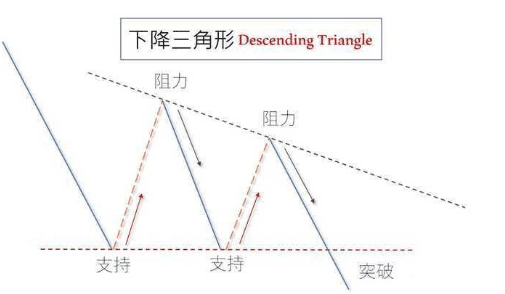
The same is true for the descending triangle
The impact of horizontal support levels on price
Less than one sudden
Finally, a breakthrough was successful
Continue a downward trend
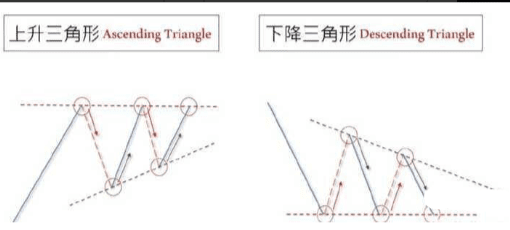
Generally speaking
The price must touch this pattern at least 5 times
3 up and 2 down or 3 down and 2 up
More than five times is no problem
But if you enter the market immediately just because it breaks out
It's a very risky behavior
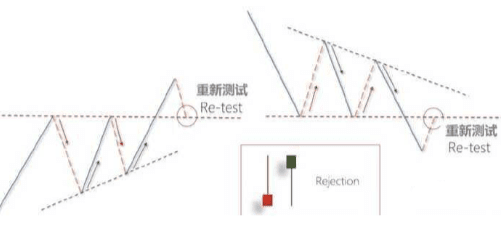
In the theory of PriceAction
There is a very important concept called Re-Test
Also called backtesting
Meaning
Regardless of the market and target
After the price breaks through the key level
Often they will call back to the key position

For example, the 4-hour chart of BTC in the figure above
After the price broke through $40,000, it did not reach a new high, and then immediately turned around and retreated, and then rebounded and returned to the high of $40,000.
It took only 5 days in total, which is a very favorable backtesting example.
Therefore, in order to improve the success rate of trading, I usually wait for the price to break through and then return to the pressure level or support level of this level.
Wait for the market to test me again. If I see a clear rejection, that is, a long candlestick shadow or something similar,
I will enter the market only when the situation is right. Although this approach is more conservative and sometimes you will miss some trading opportunities, this method is very conservative.
The success rate of this method will be much higher than entering the market based on its breakthrough.
What the market lacks the most is trading opportunities. What it lacks the most is patience. Whoever has patience can make money.
For example, in the market situation in the above picture, people without patience would think that the price is falling from 41,000, and they would not dare to chase the decline and short, nor would they dare to go long.
Those who only blame themselves for not seizing the opportunity, while those who learn to use PriceAction and know how to backtest, are waiting to buy at the bottom.
Because he believes that the price will go back up again
So I bought the bottom at around 30,000
Enter the market with a heavy position
When the price stops at 40,000 for a short time without breaking through the key level
Close the position immediately
Go short again
One big wave can make you a fortune
This is called waiting for the right opportunity and making a stunning debut!
Seeing this, I believe everyone is interested in PriceAction
And the K-line pattern and chart pattern derived from it
I have a preliminary understanding. If you think it is helpful to you, please like it and save it.


